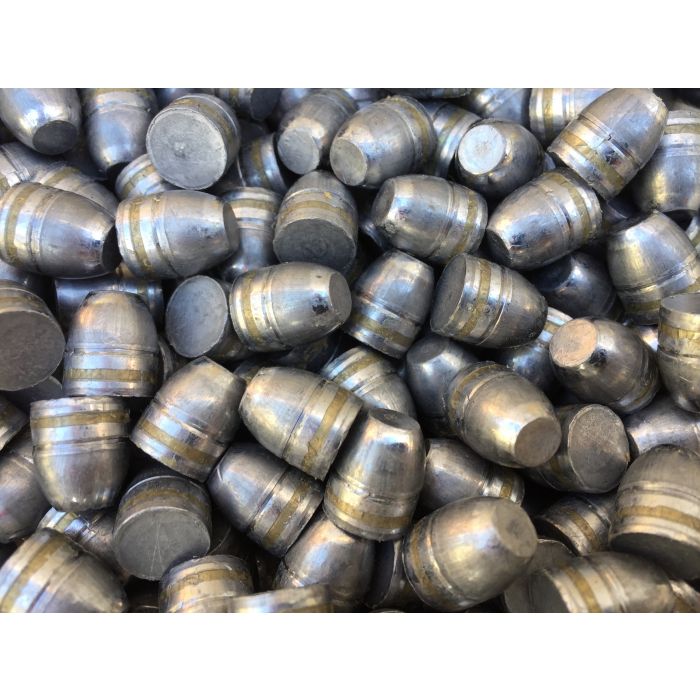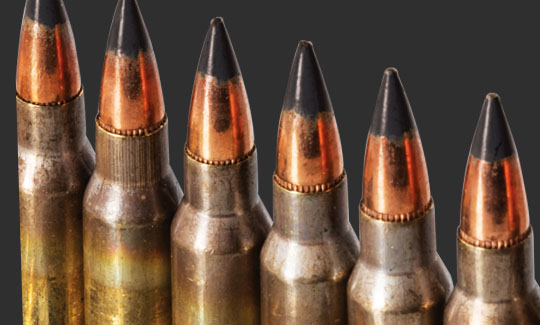Quick Guide to Bullet Types
In the realm of firearms, there are so many kinds of bullets, each with their own unique features and purposes. Certain bullets are more popular than others and this guide will focus on the most prevalent kinds seen in America, as well as their various applications. Whether you're an experienced gun user, just starting out or interested in learning more this guide is for you.
What are the different types of ammunition projectiles?
The most common bullet types found in America are Full Metal Jacket (FMJ), Hollow Point, and Armor Piercing. However, there are even more that can be found in the wide world of ammunition. Below we've included some of those you can't always find in your local gun shop.
Full Metal Jacket (FMJ)
Photo Credit:
Target Barn
Full Metal Jacket bullets are the most commonly used projectile type across the world. They're a popular choice for both leisure shooting and duty purposes. FMJ bullets are usually composed of a soft core, often made of lead, that's encased in a hard outer shell which is normally made of copper. The jacket protects its core when fired and helps the bullet hold its shape and stability as travels through the barrel and in its flight through the air. This design allows the bullet to travel farther while delivering more force than a soft core bullet could on its own.
Solid Material Bullets

Photo Credit:
NE Reloading
These are generally specialty use projectiles used in special circumstances i.e. cowboy style
firearms and antiques (solid lead bullets). There are also bullets used in hunting and lead free zones which is where you'll find a lot of options for solid copper bullets.
Armor Piercing (AP)

Photo Credit:
USCCA
Armor Piercing bullets are a military designated round. AP rounds specifically for
handguns are illegal for civilians to import. They can be identified by their black tips and they have a steel core which is designed to go through Level 4 plates. In the average person's mind, any round that can go through Level 3 armor may be considered as "armor piercing." However, this is technically incorrect because there is a legal definition of what constitutes an "armor piercing round" which has been defined by the ATF and NIJ.
While AP rounds for small arms can be manufactured by companies and certain FFL's they can only be sold to the military or law enforcement entities which are all tracked and recorded by the government.
Hollow Point
Photo Credit:
Steinel Ammunition
Hollow Points are another common projectile found in America. It's designed to expand upon impact, creating a larger wound channel and reducing the risk of over-penetration. For this very reason, hollow point bullets are typically used for personal defense as well as hunting. Hollow points are the rounds that expand and deform on impact, creating an aesthetic flower shape which can often be seen at ranges that use steel targets
Semi Jacketed Hollow Point (SJHP)

Photo Credit:
USCCA
Semi-Jacketed Hollow Point projectiles have a partial jacket surrounding a lead core, with an exposed tip. The exposed tip is what makes this type of projectile unique, as it is designed to expand upon impact. This expansion helps to transfer more energy into your target, making it a popular choice for self-defense and hunting. SJHP projectiles are also commonly used by law enforcement, as they provide a good balance between accuracy and stopping power.
Jacketed Hollow Point (JHP)
Photo Credit:
Wideners
Jacketed Hollow Point projectiles are similar to SJHP projectiles, but have a full metal jacket that completely surrounds a lead core. This type of projectile is designed to expand upon impact, creating a larger wound channel. This makes JHP projectiles an excellent choice for self-defense, hunting, and law enforcement use. JHP projectiles are known for their accuracy and stopping power, making them a popular choice among
gun owners.
Flat Nose (FN)

Photo Credit:
Midsouth Shooters Supply
Flat Nose bullets are flat on the end and are usually used by revolvers or other firearms/instances where you need to fit a specific firing mechanism length such as the 1873 Winchester rifle. The advantage of the flat nose projectiles is that they can be heavier while still fitting in your magazine which is why we do see them in use for common handgun calibers as well (9mm, .40, .45). Compared to round nose bullets, you can't achieve a heavier weight without taking up more space in the magazine. For some guns, their ammunition may be solely flat nose rounds. As an example, if you have a 30-30, they'll typically be flat nose rounds due to the tubular magazine.
Round Nose (RN)
Photo Credit:
American Hunter
Traditionally an older style of bullet designed in the late 1800's and is now commonly used in lever actions to prevent primer detonation when in tubular magazines. They're also popular with for some as their main hunting preference round.
Soft Point (SP)

Photo Credit:
NRA Women
Soft Point projectiles are a semi-jacketed bullet that isn't flat or sharp ended. It's the original bullet design from when smokeless powder was first invented. Soft points can often be seen in hunting rounds because they still have good expansion upon impact with more penetration than most hollow point rounds. It is similar to flat nose projectiles in that they are generally heavier than other style bullets but soft points will perform better and longer distances than flat nose rounds will.
Boat Tail (BT)

A flat based bullet on the left and a boat tail bullet on the right. Photo Credit:
Guns and Ammo
Boat Tail is a curved shape added to the bottom of rifle projectiles that allow bullets to have less wind turbulence and air drag allowing it to have better long distance performance and accuracy (similar to how high performance cars have rear ends designed to control air flow and drag vs a normal street car). Its name derives from the fact that it resembles the stern of a sailboat.
Projectile Weights
Projectile weight also plays a role in determining a shooter's use case for a bullet. Lighter projectiles are typically used for target shooting, while heavier projectiles are used for hunting and personal defense. Heavier projectiles have more mass and therefore generate more energy upon impact, making them ideal for use in competition, duty, hunting or personal defense scenarios.
Bullet weight can have a significant impact on its performance and the purpose for which it is used. Below are a few of the most common use cases and applicable rounds most associated with them.
Personal and Home Defense 9mm:
- Full Metal Jacket: 115-124 grain
- Hollow Point: 124-147 grain
.308:
- Full Metal Jacket: 150-180 grain
- Hollow Point: 160-200 grain
5.56x45 NATO:
- Full Metal Jacket: 55-62 grain
- Hollow Point: Not used in military applications
- Armor Piercing: 62-75 grain
This is just a drop in the bucket of an enormous range of calibers across an even more vast range of bullet weights. If you have an inkling to go down the rabbit hole reloading manuals have lists of all caliber types and document associated projectile weights you can find around the market. Just know bullet weight is important but is always hand in hand with one other topic most shooters at all levels may not pay as much attention to.
What bullet type works best for me?
Understanding different bullet types and weights available is important to make an informed decision when purchasing ammunition. It's a matter of choosing the right tool for the right job. Whether you are looking for personal and home defense, hunting, duty, or competition, there are a variety of options available to suit your needs. Each projectile type can have a significant difference in terms of accuracy or stopping power. The importance of understanding these becomes even greater if you are looking into reloading your own rounds as it then can become a safety issue as well.





